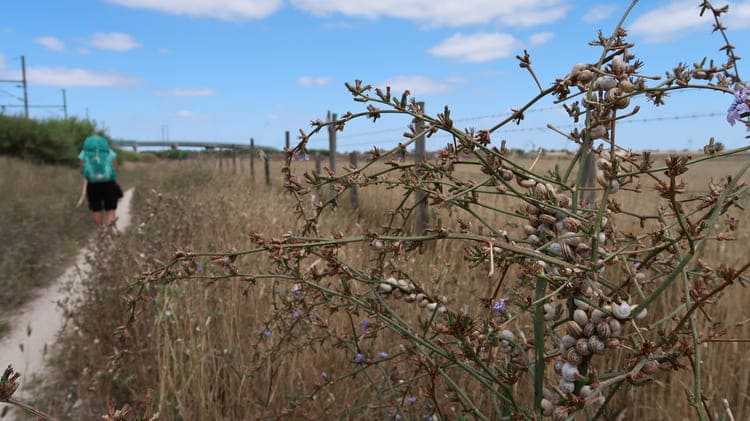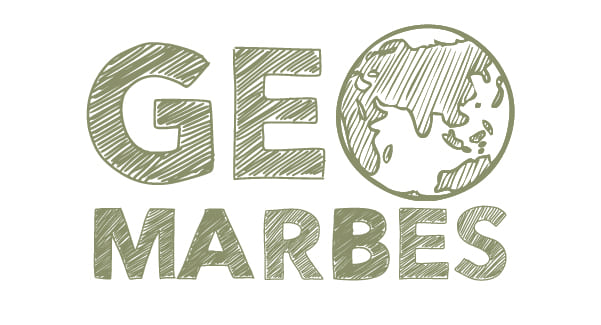The morning sun is luring us out of the bed and we’re taking our backpacks and slowly starting our pilgrimage, to the cathedral Sé.

To the cathedral
The cathedral should be open from 9 a.m. according to the information from the internet and since it’s about 8, we decide to fill the road there with geocaches and walking through the almost empty streets of Lisbon.
We’re getting to the cathedral a few minutes before 9. We see a pilgrim woman with a backpack on the stairs so we attempt to say hello in English and hopefully start a conversation. After introducing herself as “I’m Hanka” it’s quite sure we can switch to our natural language.

After a few sentences the cathedral’s gate opens and we’re going in with our credentials in our hands. Hanka does not have one and is planning to buy one here. We’re unlucky though, we’re told to wait until 10 a.m. At least that’s what someone I’m estimating for a churchman, caretaker or security guard tells us, ie. after the cleaning lady the most important person in this building. But Hanka is pressing that we can’t wait and so he eventually brings the credential and sells it to her. The next round of pressing ends up with him taking the credentials from all of us and bringing them back stamped after a while. Thereby we have our visitation of the cathedral confirmed and we’re now ready to go.

Apparently, we should start walking from here but we’re going to listen to the advices of some more experienced pilgrims who say it’s better to start the pilgrimage outside of the industrial zone of Lisbon. Hanka agrees so we’re now heading towards the direction of the train station. The public transport card is invalid here so we have to buy a new card for € 0,50 + a ticket to Vila Franca de Xira. That costs € 2,25. The train is already in the station so we get in. The road is only a few minutes long which we fill with a conversation with Hanka.
„ We are not traveling to escape life; we are traveling to not miss life. “
We’re getting out in Vila Franca de Xira and starting our route. Hanka tells us that she’s a student and that unlike us it’s not her first Camino and that she has a 3 weeks break and that she’s planning to go the whole way to Santiago. “She’s crazy,” I’m thinking in my head because it would mean she would have to walk about 30-35 km daily no matter what the weather or her health condition is. But hopefully she knows what she’s doing.
Bamboo stick – a pilgrim´s friend
The route goes very well. We find some dry bamboo stems along the way which immediately turn into our walking sticks. After about 10 km we are stopping in the first village for refreshment and to fill the water. Hanka, who has even less time to complete the Camino than we do says goodbye and after an exchange of contacts continues her route.

We order two 1,5 liter bottles of water, two coffees with milk and two Cokes in the small café. The price under 5 Euro for all of it makes me think that the lady must have fooled herself but according to the receipt it’s correct. The coffee is delicious and even the sugar from Coke brings us a feeling of energy for the upcoming kilometers. Not far away from the café we stop by a bench and change our socks. It’s important for us to have our feet dry, we don’t want to have to deal with blisters right the first day. We’re continuing and the route, which constantly switches from roadway to a grass road passes very quickly.
Look out – a train!
We stop now and then for refreshment from the blackberries that bind the way. We walk on the roadway for a while and there’s a field full of ripening peppers around us. We pass through a village where they obviously keep the siesta. Then follows crossing the railway in a small town Vila Nova da Rainha and a never-ending walk through a dirt road along the railway, where we’re having several heart attacks thanks to the passing express trains. The strong wind makes it impossible to hear the trains coming so we really notice them right when they’re passing us and so it’s no wonder that we’re trying to jump off the way at first.

The right side unlike the left one changes and so we’re walking around a rice field for a while and then water tanks where we can see a lot of crayfishes. The road is also passing a lot faster by looking for geocaches and filming videos for YouTube.
Right before hitting the goal of the day, we walk through a literal jungle in a town called Azambuja. We finally see the town at its end. We’re sitting down to the shadows close to a gas station and just relax for a while.
There are big spots appearing on Jitka’s calves, probably a result of some plant or animal hiding in the tall grass that we just went through. She says it does not hurt so let’s hope it fades away as fast as it appeared.

Albergue
Our legs are sore after the short relax and it’s hard for us to get up. We pick up our bags and go looking for our first albergue. Albergue is a hostel for pilgrims. To be able to check in, we have to show our credentials (pilgrim ID card). We always get a stamp on our credentials; each stamp is original and specific for each albergue. The stamps then serve as a proof in Santiago that we completed the pilgrimage.
Albergue are either urban, ecclesiastical or private. Some are completely free or donativo (with a voluntary contribution) or with fixed rate. That is mostly from 5 to 10 Euro for a bed, with the private albergues the prices go a litte bit higher.
First bunks
Our albergue is supposed to be in the center, but no matter how hard we look, we can’t find it. There isn’t a single soul either so we can’t even ask anyone for directions. The direction indications just don’t want to lead us there. Eventually we pull out our phones and finally find a way there thanks to online maps.

After knocking we’re getting to a small room with a rounded table behind which is sitting a black woman who immediately wants to see our credentials. She says the lodging costs €6 for a person.
We occupy two lower bunk beds. There are already some people resting on the beds next to us so we quietly and carefully pull out our towels and go to the shower and wash the sweaty clothes.
The shower is refreshing and since we don’t feel any extra tired, we go and take a walk around the town. We stop at a café where we’re lured by their menu of waffles. We order two coffees with milk, two Cokes and two waffles. When I hear the final price €5,50, I leave a tip €0,50 and the waitress almost makes a bulge on her forehead. Maybe it was too much but I’m honestly in shock by how cheap it is. The waffles are delicious and fill our bellies well. After this sort of dinner, we go to a supermarket that is right beside to buy some water for the next day.
Where is the phone?
On our way from the store Jitka reaches for her phone but it’s nowhere to be found. I try to call her but it says her phone is unavailable. We’re getting nervous after realizing we might’ve left it on a table in the café. We quickly walk back where we sat and all we see is a clean and empty table. We ask the waitress if she possibly found a phone here but she says she didn’t. Fortunately, Jitka remembers that she put her phone in her backpack pocket when paying in the supermarket and so the shame with looking for the phone isn’t that big.
The return to our guesthouse goes with no problems and we’re finally feeling kind of tired. The albergue has become much fuller while we were gone. Out of 12 beds 9 are already taken.
At dusk we call home to Terka and after wishing her a good night and knowing we’ve fulfilled our today’s goal – 22 km, we go to sleep.
